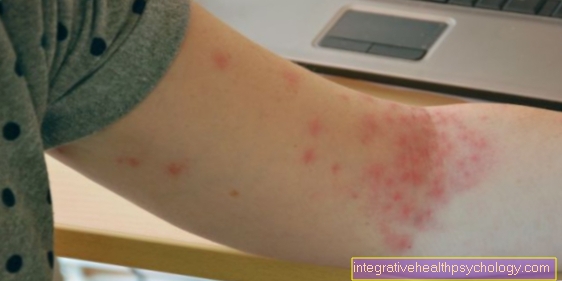Cortisone spray
General
Cortisone sprays are among the commonly used and well-tolerated drugs that can be used for a wide variety of diseases. They contain inhaled glucocorticoids, which have local anti-inflammatory, anti-allergic and immunosuppressive effects, making them suitable for the treatment of diseases such as asthma and chronic bronchitis.
Cortisone sprays are among the commonly used and well-tolerated drugs that can be used for a wide variety of diseases. There are, among other things, nasal sprays, which are often recommended for allergy sufferers, inhalative sprays, which are mainly used in asthma, and sprays which are applied to the skin. The term cortisone spray does not only mean sprays that contain the active ingredient cortisone, but also other so-called glucocorticoids. These include, for example, the active ingredients budesonide or fluticasone.

What the glucocorticoids have in common is an anti-inflammatory and immune-suppressing effect. The latter sounds rather negative for many people, but this effect is often desirable, for example in the case of allergic reactions or an autoimmune disease.
Nevertheless, after using the spray, it is advisable to eat something or to rinse out your mouth with water, as otherwise oral thrush or irritation in the mouth area can occur.
The following article deals with interesting facts and questions about the topic of "cortisone sprays" and tries above all to present information relevant to everyday life, such as indications, effects and side effects, of various sprays in a compact and understandable way.
You might also be interested in: Effects of cortisone
How cortisone works
Glucocorticoids combine common principles of action, of which anti-inflammatory and immunosuppression are to be emphasized. "Immunosuppression" means an inhibiting effect on the body's own immune system, which is particularly desirable in the case of an over-sensitive immune system or an autoimmune disease. Anti-inflammatory properties are beneficial for many diseases and can improve both acute symptoms and chronic consequences. In the case of asthma, for example, this not only improves breathing and the well-being of the person affected, but also prevents long-term negative restructuring processes in the lung tissue.
The effects are sometimes complicated and work on different levels in the organism.
Glucocorticoids bind to receptors inside the cells, which cause changes in gene expression (formation of proteins based on DNA). For this, they must have lipophilic (fat-soluble) properties in order to be able to cross the cell membrane well.
This altered gene expression then leads to the anti-inflammatory, antiallergic and immunosuppressive properties of the glucocorticoids.
So basically all glucocorticoids work similarly. However, they differ in their potency.
The potency is compared to cortisol, the hormone that occurs naturally in the body. Commonly used ingredients like budesonide and fluticasone are more effective compared to cortisol.
This effect is desirable because a higher effectiveness is necessary for the treatment of diseases.
Applications of cortisone
The areas of application for cortisone sprays are very diverse. Skin and lung diseases as well as allergies are treated with cortisone sprays. The following section provides a clear overview of the most important indications for a cortisone spray.
Cortisone sprays for inhalation use
For asthma or recurrent obstructive bronchitis
For the long-term treatment of childhood asthma or recurrent (spastic) obstructive bronchitis, inhaled glucocorticoids are the first choice.
A cough that occurs from the flu or cold is not treated with cortisone sprays.
However, coughing can also occur in the context of asthma or recurrent obstructive bronchitis. In this case, cortisone sprays are used in long-term therapy and help to alleviate the symptoms over the long term.
A very frequently used active ingredient is budesonide. There are not only inhalers, but also cortisone nasal sprays that can be used to treat asthma.
You might also be interested in the following topic, as it describes in detail all areas of application of cortisone in children: Cortisone in the child
With early use and consistent therapy, these improve the prognosis, the lung function values and reduce the frequency of severe asthma attacks.
However, they are not suitable for the acute treatment of an asthma attack or obstructive bronchitis.
Colds are not treated with cortisone sprays, including cortisone nasal sprays.
A cold can neither be improved nor cured by using cortisone sprays.
bronchitis
There are different types of bronchitis. Acute bronchitis is usually caused by a viral infection and heals on its own. Cortisone sprays are not indicated in this case.
Bronchiolitis is a special case (RSV infection), which often occurs in infancy and young children. This condition can also be treated with cortisone sprays. In the case of obstructive bronchitis, bronchial asthma or COPD, however, cortisone sprays are regularly used therapeutically.
Pseudo croup
In the case of a child's croup, which is mainly associated with a nightly, barking cough and breathing difficulties, cortisone sprays can also be used for inhalation .;
COPD
The abbreviation COPD stands for chronic obstructive pulmonary disease. Inhaled cortisone sprays are also used in the widespread COPD.
These are used in advanced stages of the disease. Common active ingredients are budesonide, fluticasone and beclometasone.
Cortisone spray for allergies
Allergic rhinitis
Allergic rhinitis, or rhinoconjunctivitis, is known to most people in its seasonal form as hay fever. Non-seasonal rhinitis is often referred to as a house dust allergy. These allergies are common triggers for an asthma attack in asthma sufferers, so they should be treated.
Both allergies can be treated with cortisone nasal sprays. A common active ingredient is budesonide.
Such nasal sprays are also suitable for long-term therapy.
Cortisone spray for skin diseases
Various skin diseases, burning rashes, such as sunburns or allergic eczema can respond to a weak cortisone spray (usually hydrocortisone).
The decision is to be made individually and very much depends on the individual clinical picture and the sensitivity of the skin.
The sprays are applied directly to the skin and are suitable for short-term use. Not every dermatosis (skin disease) can be treated with such a spray,
therefore the decision is to be made very individually in consultation with a dermatologist.
It is often necessary to try out whether there is any improvement during the treatment.
Use of cortisone spray
The dosage for a cortisone spray depends on various factors and therefore cannot be given across the board.
Cortisone sprays are used for a wide variety of diseases and for people of different ages. Furthermore, there are also different active ingredients that are also dosed differently. Therefore, no dosing schemes can be specified at this point. In long-term therapy in particular, many factors have to be considered in order to find the right dosage.
The drug is used according to the prescription of the attending physician. Regular use is important, not just when needed!
Powder inhalers, solutions or so-called metered-dose aerosols are used for inhalation.
If possible, inhalation should be carried out immediately before eating. Otherwise, the mouth should be rinsed out with water immediately after inhalation (then spit out) so that oral thrush can be prevented as much as possible.
These measures can also reduce irritation of the throat and systemic side effects of the glucocorticoids.
Read more on the topic: Taper off cortisone
Contraindications during the use of cortisone spray
The cortisone spray should not be used if hypersensitivity (allergy) to one of the ingredients of the spray exists or occurs during treatment. Other, partially limited, contraindications are:
- untreated respiratory infections
- untreated eye infections
- children
Side effects of cortisone spray
Even if most cortisone sprays are very well tolerated, side effects can always occur with drugs.
These differ from one product to another and also depend on the individual characteristics of the patient. Some patient groups, who have many previous illnesses, for example, usually have a higher risk of side effects than otherwise healthy patients.
In general, cortisone sprays that are inhaled can cause fungal infections of the oral mucosa. Furthermore, the long-term use of inhaled cortisone sprays can damage the vocal cords and cause hoarseness. Systemic side effects can only occur in very rare cases. These include irritability, restlessness, glaucoma or cataracts, a decrease in bone mineral density, and decreased activity of the adrenal cortex.
Cortisone nasal sprays can cause side effects such as nosebleeds, irritation of the throat and nose, sore throat, burning of the mucous membranes, infections of the upper respiratory tract, headaches or ulcers of the nasal mucosa.
In general, however, they are very well tolerated, so that side effects are less common.
Cortisone skin sprays can also have side effects. The most common side effect is an allergic skin reaction. Overall, however, this is also a rare side effect. Even less often, and only with long-term use of the spray, the skin may become thinner (skin atrophy), skin capillaries become visible, steroid acne,
excessive hair growth on the skin (hypertrichosis) or signs of drying of the skin. Stretch marks can also develop.
The amount of glucocorticoids that is absorbed into the bloodstream of the body by a cortisone spray and thus can cause systemic side effects is very small and thus the use of glucocorticoids by spray is much more tolerable than the systemic use, for example as tablets.
You might also be interested in: Side effects of cortisone
Drug interactions
Glucocorticoids are metabolized and broken down in the liver by special enzymes (CYP450).
Therefore, drugs that are also metabolized via these enzymes can inhibit or increase their activity. This can lead to interactions with cortisone sprays.
Many antifungal agents such as itraconazole, ketoconazole or HIV drugs such as ritonavir and nelfinavir, antibiotics such as troleandromycin and erythromycin and the drug ciclospoprin A inhibit this important enzyme and thus prevent the breakdown of glucocorticoids. Not only medication, but also grapefruit juice, for example, leads to an inhibition of the CYP450 enzyme.
With these so-called CYP inhibitors, the glucocorticoids accumulate in the body and their effect, but unfortunately also their side effects, can be increased.
Apart from the enhancers, there are also active ingredients that promote the breakdown of cortisone sprays in the liver.
These are, for example, the anti-epileptic carbamazepine and the antibiotic rifampicin. This may mean that a higher dose of the cortisone spray may be necessary.
In women who take hormonal contraceptives - apart from the mini pill - the concentration of the cortisone spray can also be increased, the effect is thus increased and the risk of side effects can increase.
Glucocorticoids can also affect the excretion of potassium and cause potassium deficiency (hypokalaemia).
This potassium deficiency promotes the effect and also possible side effects of digitalis preparations.
You might also be interested in: Cortisone and alcohol - are they compatible?
Price for cortisone sprays
The price for cortisone sprays is very different and depends on the respective preparation. Many sprays require a prescription, for example for asthma or COPD.
However, the costs for such sprays are also borne by the health insurance company, since they are necessary medications. An example of such a preparation is a budesonide inhalation spray.
This costs around 40-50 euros and usually contains 200 single doses.
Over-the-counter cortisone sprays that have to be paid for privately include some nasal sprays or skin sprays.
The price for a cortisone nasal spray is usually between 5 and 10 euros. Skin sprays can be found from a price of 3 euros.
Read detailed information on: inhalation




























